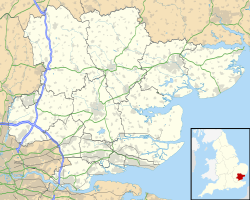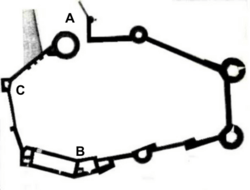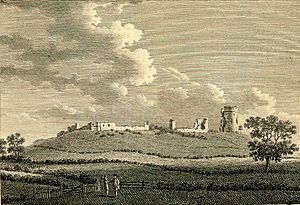Hadleigh Castle facts for kids
Quick facts for kids Hadleigh Castle |
|
|---|---|
| Essex, England | |

Aerial view of Hadleigh Castle from the north, with the Thames Estuary in the background
|
|
| Coordinates | 51°32′40″N 0°36′32″E / 51.5444°N 0.6090°E |
| Site information | |
| Owner | English Heritage |
| Open to the public |
Yes |
| Condition | Ruined |
| Site history | |
| Materials | Kentish ragstone |
Hadleigh Castle is a ruined castle in Essex, England. It stands high above the Thames Estuary, south of the town of Hadleigh. The castle was first built after 1215 during the time of King Henry III. It was built by Hubert de Burgh, a powerful nobleman.
The castle was surrounded by a large park. It played an important role in the local economy and defense. Later, King Edward III greatly expanded and rebuilt the castle. He wanted it to defend against possible attacks from France. He also wanted a comfortable private home near London.
Hadleigh Castle was built on soft clay soil. This meant the ground often shifted, causing parts of the castle to sink or collapse. This problem, along with the sale of its stones in the 1500s, led to the castle becoming a ruin. Today, the remains of the castle are cared for by English Heritage. It is protected by law as a Grade I listed building and a scheduled monument.
Contents
The Castle's Story: A Look Back in Time
Building Hadleigh Castle: The 1200s
Hadleigh Castle was first built by Hubert de Burgh. He was a strong supporter of King John. In 1215, King John gave de Burgh the area of Rayleigh as a reward. Instead of improving the old Rayleigh Castle, de Burgh decided to build a new one. He chose a spot south of Hadleigh.
We don't know the exact year the castle was built. But it's thought that work started early in de Burgh's time there. King Henry III officially approved the castle's defenses in 1230.
Why This Location Was Chosen
The castle was built on a ridge in South Essex. This spot overlooked the Thames Estuary. The ground here was mostly soft clay. In the 1200s, marshlands stretched out to the south. The tide sometimes reached the base of the hill. The area also had more trees than it does today.
By 1235, the Hadleigh Park was created around the castle. It had woodlands, a fishpond, stables, and a park lodge. The castle was also connected to a larger estate. This estate included Rayleigh, Thundersley, and Eastwood Parks.
What the First Castle Looked Like
The first castle likely had an eight-sided shape. It followed the top of the ridge. Square and round towers protected its walls. A barbican guarded the main entrance on the east side. It might have looked similar to White Castle in Wales. That castle was also rebuilt by de Burgh around the same time.
Hadleigh Castle was built using Kentish ragstone. The mortar holding the stones together had many seashells in it. These were mostly cockleshells from nearby Canvey Island. By 1249, a valuable tidal watermill was built. This mill was very important for making bread for the castle. Recent discoveries suggest it was on a wharf reaching into the estuary. This wharf was just southeast of the castle. Terraced gardens were built along the south side. They overlooked the estuary and probably included vineyards.
Changes in Ownership
Hubert de Burgh eventually lost favor with King Henry III. He was put in prison and then lost Hadleigh Castle in 1239. For the rest of the century, Hadleigh remained a royal castle. It was part of a large estate. This estate included 142 acres of farmland, the park, and the castle mill.
By the 1250s, the castle was not well cared for. Even after Queen Eleanor received it in 1273, it stayed in poor condition. Only the mill, which was vital for the estate, seemed to be maintained. Around 1290, a new large hall and royal rooms were built. But they soon collapsed because of the soft ground. In 1299, Queen Margaret was given the castle. She complained about its condition and demanded repairs. Her husband, King Edward I, visited the castle twice. He used it as a base for hunting.
Royal Residence: The 1300s
King Edward II became very interested in Hadleigh Castle. This led to a time of major repairs and rebuilding. This continued during the reign of his son, King Edward III. Edward II first stayed there in 1311. Work was done to get the castle ready for his arrival. This included building new royal rooms and fixing walls damaged by sinking ground.
During this time, the castle had a hall, larder, kitchen, cellar, and a prison. It also had an "old chamber" and an armoury. A group of 24 soldiers guarded the castle during times of trouble. Edward II often stayed there until 1324. Sometimes, he traveled to Hadleigh Castle from London on his royal boat. The boat would dock at a wharf south of the castle.
Edward III's Grand Rebuilding
King Edward III took over Hadleigh Castle in 1330. He got it back from his mother, Isabella of France. She had taken it when she removed him from power in 1326. Edward didn't pay much attention to the castle at first. But in the 1360s, he decided to use it much more. He ordered large parts of it to be rebuilt. This cost more than £2200, a huge sum back then.
Between 1361 and 1363, the inside buildings were updated. New royal living areas were built along the south walls. After this, the east side of the castle was completely rebuilt. Two large round towers were added to a new section of wall. This work was finished by 1365. The north side of the castle was also rebuilt. It included a main entrance with a portcullis (a heavy gate) and a drawbridge. A barbican and a large round tower, called the "High Tower," protected this entrance. This was completed by 1370. William of Wykeham likely managed all this building work.
Why Edward III Rebuilt the Castle
Historians first thought Edward rebuilt the castle because of growing tensions with France. They believed Hadleigh would be an important coastal fort. It would protect the Thames Estuary from French raids. However, today's historians think differently. They note that relations with France were unusually good when the work was done.
Instead, it's now believed that the aging Edward wanted Hadleigh as a private retreat. It was close to London, where he could stay in comfort. The entrance on the land side remained simple. But the new buildings made a grand impression from the estuary. Any visitors to London, English or French, would see Queenborough Castle on the south bank and Hadleigh on the north. This showed off the King's power.
Later Years: 1400s to 1800s
King Richard II, Edward III's grandson, didn't use Hadleigh much. The castle was given to Aubrey de Vere until he died in 1400. During the 1400s, the castle was owned by several important people. But the royal family didn't use it often.
It was passed to Edmund of Langley and his son Edward of Norwich, the Dukes of York. Then it went to Humphrey of Lancaster, the Duke of Gloucester. Next, Richard, Duke of York, used the castle. In the mid-1400s, it passed to Edmund Tudor.
The tradition of the castle being part of the queen's property returned. It was given to Elizabeth Woodville, wife of King Edward IV. King Henry VIII didn't use the castle himself. But it was part of the property given to three of his wives: Catherine of Aragon, Anne of Cleves, and Catherine Parr. The castle's parks were used to get wood for his navy.
The Castle Becomes a Ruin
After 1544, the Hadleigh estate began to be sold off. First, the parks were sold. Then, the castle itself was bought by Lord Richard Rich. He bought it from King Edward VI for £700 in 1551. Rich took the castle apart to sell its stones. This happened mostly between 1551 and 1575. The castle became a complete ruin. It then passed down through Rich's family.
Hadleigh Castle in Art
The English painter John Constable visited Hadleigh in 1814. He drew the castle to prepare for ten oil sketches and one painting. His oil painting, Hadleigh Castle, was finished in 1829. It was shown at the Royal Academy that same year. One of his sketches is at the Tate Gallery in London. The painting is now in the Yale Center for British Art in New Haven, United States.
Constable's painting is considered one of his most important works. It shows Hadleigh Castle in the early 1800s. It looks like a decaying, man-made structure. It appears to be giving in to the powerful forces of nature.
The Salvation Army's Role
William Booth bought Hadleigh Castle and the land around it in 1891. He bought it for the Salvation Army. They set up a farm there. The farm trained poor English people before they were sent to live in British colonies overseas. Between 1898 and 1923, a lot of ground movement occurred. This caused the southern castle wall to collapse.
Hadleigh Castle Today
The Salvation Army gave the castle to the Ministry of Works in 1948. Today, English Heritage owns it. It is protected as a scheduled monument and a Grade I listed building. The ground continues to shift and cause landslips. The north-east tower mostly collapsed in the 1950s. More major collapses happened in 1969, 1970, and 2002.
One of the three-story towers on the eastern side still stands almost to its full height. It has narrow rectangular windows on its upper levels. The second tower has only about one-third of its original shape left. Some parts of the main curtain wall have survived. The foundations of the great hall, royal rooms, and kitchen can also still be seen.
The castle is still surrounded by the 19th-century Salvation Army farm. Beyond that is Hadleigh Country Park. Essex County Council owns and manages this park. It is a Site of Special Scientific Interest. This means it's important for protecting special invertebrates (animals without backbones). In 2008, Hadleigh Farm, near the castle, was chosen as the place for the mountain biking competition in the 2012 Summer Olympics.
Images for kids




